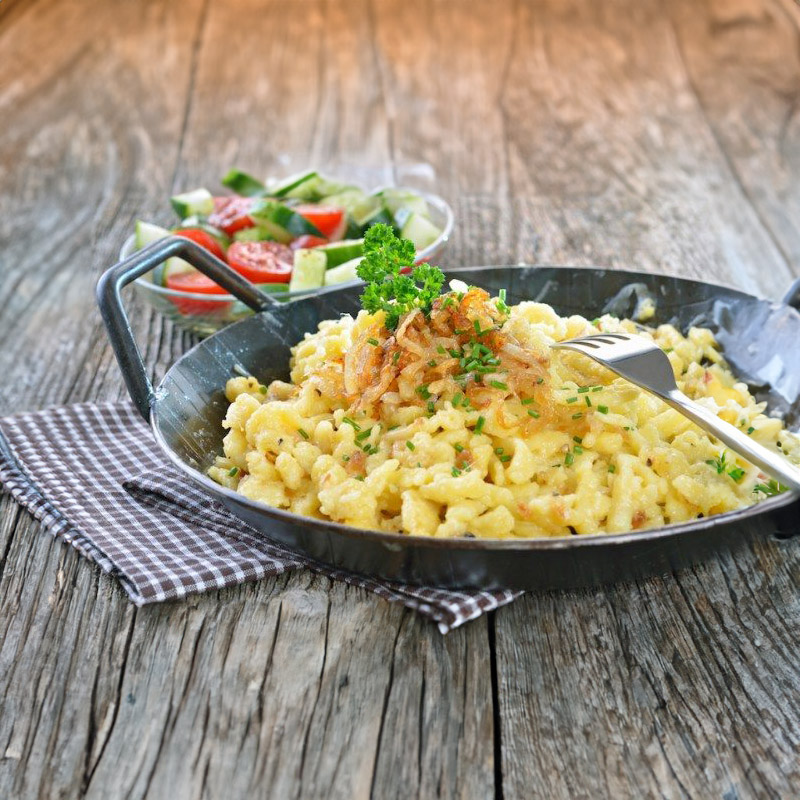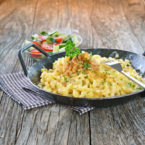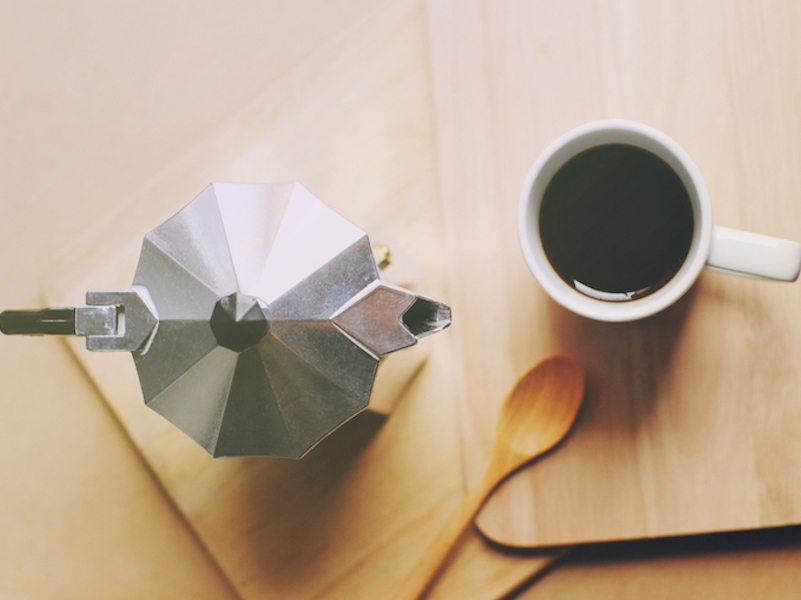Kathy Bechtel’s obsession with food and cooking began as a…
Spaetzle, or spätzle, is a rustic pasta most commonly associated with Germany, but is equally prevalent in the Sudtirol region of Italy.
This is one food that is truly regional in Italy. I never see it on our tours in the Veneto, but travel an hour north to Trentino-Alto Adige, and it is quite common. It’s a great dish to enjoy as a slope side lunch during a ski holiday at Madonna di Campiglio, or to load up on those carbohydrates before a bike tour over Passo Giau.
It is a fairly simple recipe, consisting of eggs, flour, salt, and milk or water. Centuries ago, this pasta was shaped by hand or with a spoon, scraping it off of a wooden cutting board directly into boiling water. The shape resembled small birds, giving rise to the name spätzle, which translates to “little sparrow”. Since then, several devices have been invented to form the dough, all ways of ‘extruding’ this noodle, and all reminding me of the plastic press that we used during our childhood for Playdough. Some look like flat graters with a box on top which holds the dough and slides along the holes, other resemble food mills or a strainer. If you don’t have one of these spaetzle makers, you could use a colander or flat grater, and push the dough through the holes with a metal spoon. Remember, this is rustic cooking, so don’t get too concerned about the shape! I borrowed a spaetzle maker from a friend’s mother who has been making this for years.
There are several versions of spaetzle you may find in your travels. Leberspätzle has had the dough enriched with minced pork liver; common in Sudtirol is Spinatspatzeln, spätzle that has spinach added to the dough. You may find it in soup, served with lentils, or served as a side dish to meats with sauces, like I enjoyed on a recent trip to Val Gardena.

Step by Step Guide to Making Spaetzle – Little Pasta ‘Sparrows’ From Sudtirol
-
Prepare the Dough:
- In a medium bowl, mix flour, salt, pepper, and nutmeg.
- In a separate small bowl, beat the eggs.
- Gradually alternate adding the beaten eggs and milk to the flour mixture. Aim for a brownie batter consistency.
- Adjust the dough with more milk if too stiff or more flour if too wet.
-
Cooking the Spaetzle:
- Bring a large pot of salted water to a boil.
- Use a spaetzle maker, colander, or grater to press about 1/4 of the dough through holes directly into boiling water.
- Once noodles rise to the top, skim them off with a slotted spoon and transfer to a sheet pan.
- Repeat the process until all noodles are cooked.
-
Finishing the Spaetzle:
- In a large sauté pan over medium heat, melt the butter.
- Add the cooked spaetzle noodles and stir to coat them in butter.
- Season with parsley, salt, and pepper.
- Serve the spaetzle warm as a side dish.

Spaetzle Recipe: Little “Sparrows” from Sudtirol
5 Stars 4 Stars 3 Stars 2 Stars 1 Star
5 from 2 reviews
- Author: Kathy Bechtel
- Total Time: 25 minutes
- Yield: 4 1x
Description
Spaetzle, or spätzle, is a rustic pasta most commonly associated with Germany, but is equally prevalent in the Sudtirol region of Italy.
Ingredients
- 1 1/2 cups (150 g) all-purpose flour
- 1 teaspoon kosher salt
- 1/8 teaspoon freshly ground pepper
- 1/4 teaspoon nutmeg
- 3 eggs
- 3/8 cups (90 ml) milk
- 2 tablespoons (30 g) unsalted butter
- 2 tablespoons parsley, finely chopped
Instructions
- Prepare the Dough:
- In a medium bowl, mix flour, salt, pepper, and nutmeg.
- In a separate small bowl, beat the eggs.
- Gradually alternate adding the beaten eggs and milk to the flour mixture. Aim for a brownie batter consistency.
- Adjust the dough with more milk if too stiff or more flour if too wet.
- Cooking the Spaetzle:
- Bring a large pot of salted water to a boil.
- Use a spaetzle maker, colander, or grater to press about 1/4 of the dough through holes directly into boiling water.
- Once noodles rise to the top, skim them off with a slotted spoon and transfer to a sheet pan.
- Repeat the process until all noodles are cooked.
- Finishing the Spaetzle:
- In a large sauté pan over medium heat, melt the butter.
- Add the cooked spaetzle noodles and stir to coat them in butter.
- Season with parsley, salt, and pepper.
- Serve the spaetzle warm as a side dish.
Notes
- Consistency is key; adjust the dough as needed for the perfect texture.
- For an added twist, consider adding grated cheese or caramelized onions to the finished spaetzle.
- Leftover spaetzle can be refrigerated and reheated in a pan with a little butter.
- Prep Time: 10 mins
- Cook Time: 15 mins
- Category: Side Dish
- Method: Boiling
- Cuisine: German Italian
Kathy Bechtel’s obsession with food and cooking began as a teenager. After years following a traditional career path as a telecommunications engineer, she left to attend culinary school and wine training, and is now combining her passions for food and wine, the outdoors, and travel as owner and Culinary Tour Director of Italiaoutdoors. In this role, Kathy leads small bicycle, skiing and walking tours that explore the authentic regional cuisines, local products and undiscovered wines of Northeastern Italy.



Not sure what if any difference there is from kniffla all the recipes from my South Dakota mother yes a child of German parents here in 1932 ,one of my all time favorite dishes